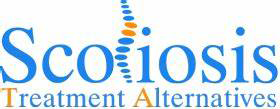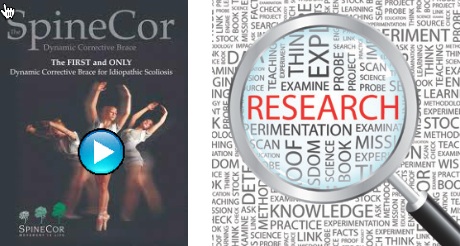Introduction To SpineCor Research
Background on SpineCor
The concept of a dynamic flexion orthosis, (the technical description of the SpineCor brace) was one of three scoliosis treatment innovations conceived by a team of 165 researchers that lead by two prominent orthopedic spine surgeons at the Research Centre in Sainte-Justine Children’s Hospital in Montreal Canada. The team was funded by the government of Quebec with $12 million dollars and they were tasked with studying the current scoliosis research literature to come up with new and improved treatment solutions for scoliosis, in order to create new innovative products that would advance the conservative and surgical treatment of scoliosis. The product that was developed to advance the conservative care of scoliosis was later named SpineCor.
To understand how significant this innovation was to the conservative treatment of scoliosis requires knowing the details of how and why it was developed. (Read More)
Since SpineCor was developed at a research center of a major children’s hospital that was the epicenter for scoliosis treatment in Montreal, it has been one of the most throughly studied scoliosis braces in the world. The following are summaries of the findings of a number of these studies on the efficacy of SpineCor as well as others from around the world.
SpineCor Research Articles
1. A Non-Rigid Brace for the Treatment of AIS: Post Treatment Results
This study on SpineCor was performed at the Medical School of the University of Montreal in 2002 and was reported in the European Spine Journal in 2003. The results of this study of 195 scoliosis patients fitted with the SpineCor brace showed that the probability of success (stabilization or correction of the curvature or minimal progression to avoiding surgery) was greater for those patients the longer they stayed in the program. It also showed continued improvement in many of the curvatures even after 2 years of completion of the SpineCor program. Of those patients who reached the 2 year mark 93% of the patients had stabilization or correction of their scoliosis curvatures.
The Scoliosis Research Society (SRS) published their guidelines for all future studies of Idiopathic Scoliosis treatments in 2006 that standardized the outcome measurements so that different scoliosis treatments could be analyzed and compared side by side. These Guidelines also have strict inclusion and exclusion criteria that only allow the study of the group of patients with the highest progression risk.
2. Effectiveness of the SpineCor Brace Based on the New Standardized Criteria Proposed by the Scoliosis Research Society for Adolescent Idiopathic Scoliosis
This study examined the effects of the SpineCor brace on 171 patients who had been fitted with the SpineCor brace and who met the study criteria. The preliminary results in 2007 showed great promise for the SpineCor braces long term effectiveness with the majority of patients (59%) showing that they had either correction or stabilization of their curvatures. In this study, of the 47 patients that had completed their SpineCor treatment and had been out of the brace for 2 years 98% of them were able to avoid surgery.
3. A 2007 published in the Journal of Pediatric Orthopedics
This research study used the latest SRS guidelines made it possible to compare brace outcomes side by side. This study compared the dynamic SpineCor brace with the commonly uses Static TLSO and Providence braces. Using the results in the above mentioned study the first study comparing the results from the dynamic SpineCor scoliosis brace was compare with two recent studies done on static scoliosis braces that also followed the SRS Guidelines. It compared the 3 popular scoliosis brace treatments. The results published in the Journal of Pediatric Orthopedics in 2007 shows a very clear difference in outcome for three different treatment methods.
The results of this study showed a dramatic difference in treatment outcomes for each of the brace treatments. The SpineCor brace was found to be 76.5% effective in avoiding surgery, while the Providence brace was found to be only 40% effective and the TLSO brace was only15% success (by SRS definitions) This meant that the SpineCor brace was found to be 4 times more effective than TLSO in stopping progression of the curve.
4. A New Concept for the Non-Invasive Treatment of Adolescent Idiopathic Scoliosis: The Corrective Movement Principle Integrated in the SpineCor System
This study showed that of the 349 patients that were treated at the research hospital in Montreal Canada 248 of them fit into the research criteria. Of those 74.2 % had either stabilization or correction of their curvatures. Only 2.7 % required surgery at the conclusion of their treatment. Of the 248 patients that continued in the study to reach follow up visit at the 2 Year post treatment mark 89.1% of them had sustained positive results (52% Correction and 37.1% Stabilization) Of that group 14.5% had continued improvement of their scoliosis curvatures after stopping the use of the brace, while only 10.9% of the patients had worsening of their curves.
Of the 117 patients that reached the 5 Year post treatment mark in the Study 91.5% of patients had a positive outcome. (58.2% Correction and 33.3% Stabilization)
Of this group 33.3%* of the patients had their curvatures improve beyond what they had achieved after stopping the use of the brace. (*This shows that the positive effects of the SpineCor brace’s changing of the neuromuscular re-patterning continue long after the cessation of wearing the brace.)
5. SpineCor dynamic bracing for AIS Department of Paediatric Orthopaedics and Traumatology, Pomeranian Medical University, Szczecin, Poland
This study performed in September 2009 which showed that 76% of the patients treated with SpineCor achieved a positive outcome (48% had correction and 28% had stabilization of their scoliosis.
CONCLUSIONS:
SpineCor research articles demonstrate that the use of the dynamic SpineCor brace resulted in stabilization and correction in the overwhelming majority of the patients in the study. Researchers concluded that begining the SpineCor brace with patients meeting the study criteria (a Cobb angle over 20 degrees with a Risser sign 0-3 resulted in very effective prevention of progression of scoliosis curvatures.
6. SpineCor treatment for Juvenile Idiopathic Scoliosis
In November 2010 study entitledby Dr. Christine Colliard and Dr. Charles Rivard was done on the effectiveness of SpineCor for the treatment of Juvenile Scoliosis patients (ages 4 to 10 year old). This study was an Award winner at the SOSORTs convention in 2010. Juvenile cases of scoliosis can be difficult to manage over time since the earlier the onset of a scoliosis the greater the chances of progression of the curvature, especially during the periods of rapid growth around puberty. Keeping a child in a hard brace for 5 to 16 years would be next to impossible, but the SpineCor brace was found to be much easier for them to tolerate for the long duration of care until they stopped growing and their curvatures had stabilized.
This study clearly showed the effectiveness of the SpineCor orthosis in these difficult cases by obtaining and maintaining improved neuromuscular integration of the corrective movement with juvenile patients. While the study is ongoing over 75% of all patients that finished the treatment at the time of the article had remained stable and a few continued to have further correction of their Cobb angle after discontinuing the use of the SpineCor brace.
CONCLUSION:
This study concluded that the dynamic SpineCor brace is an effective method of treatment of juvenile idiopathic scoliosis, especially when beginning treatment early on. While a high percentage of these cases (37%) surgical intervention could not be avoided, it was found that it could at least be postponed, which was critical since performing surgery on a child with so much growth left can result in significant complications later (ie:crankshaft phenomenon)
The commitment to research in the effectiveness of the SpineCor brace continues. As of 2010 over 950 patients have gone through treatment at the research center in Montreal and their results have been cataloged.
Additional SpineCor Studies from Around the World
Other studies of the effectiveness of the SpineCor brace have been done by independent scoliosis researchers from around the world. They have come to similar conclusions about the effectiveness of the SpineCor brace. Here is a list of these studies:
- A Retrospective Analysis of the SpineCor Brace Treatment at the Sheffield Children’s Hospital, United Kingdom Reported in the Journal of Bone and Joint Surgery in 2006.
- Preliminary Results of the Use of the SpineCor Brace in Katowice (Poland) in the Annals of Academic Medicine Siles in 2007.
- The Early Results of the Treatment of Idiopathic Scoliosis Using the Dynamic SpineCor Brace. In Medical Rehabilitation in 2008.
- Initial Results of SpineCor Treatment of Adolescent Idiopathic Scoliosis in Seville Spain. In Scoliosis in 2009.
- Use of the SpineCor Dynamic Corrective Brace in Greece: A Preliminary Report in Scoliosis 2009.


I live and practice in Iran in past few years. Unfortunately surgical interventions seems to be the only treatment available in the country. Although there are few chiropractors, myself included, that are trying with same old conservative treatments that are not effective. I have used some basic schroth’s exercises which has provided some hope, however is not enough. My question is how can i learn and be part of the spine core providers in Iran.
Dr. Ghalbi,
Thank you for your interest in our Doctor training programs for scoliosis treatment. We are starting them in September. If you’d like more information please give us a call at (800) 943-1254 and ask to speak to Dr. Marc Lamantia.
This is great that you are offering information on research studies. I have wondered about this since starting to use SpineCor brace for my son about a year ago. Why are there not more recent studies published? The most recent referenced above is nearly 6 years old.
Kevin,
I’m sure there have been more recent studies done on SpineCor that I just have not posted yet. I’ll look to update the posts in the near future.
Thanks for bringing that to my attention.
I am a 73 year old woman with an S curve,about a 55% curve. Will spine for help me. Will it stop the progression of the curve and reduce the pain.
Carol,
About half of all the patients we help with scoliosis each year are adults, many of which have severe curves like yours and many of those are around your age or even older. So it is possible that SpineCor can help you too. What I would recommend is that you contact us and schedule a Free Scoliosis Phone Consult with one of our doctors to find out if SpineCor and Schroth are right for you.
I have s curve in spine with 4 herniated disc in thoracic region that I’m having issues with t7 with radiopothy (sp?) I also have degenerative disc disease. Would you think it would help with the curve and disc pain
Amy,
it is certainly possible that SpineCor could help you. The best way to find out is for you to schedule a Free Scoliosis Phone Consult with one of our doctors nearest you by clicking on the above link.